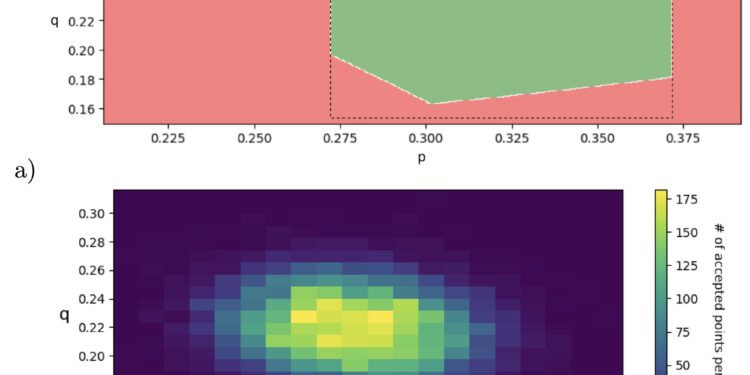Three classes of parameter inference methods for DTMCs with steady-state data measurements. Credit: PLOS ONE (2023). DOI: 10.1371/journal.pone.0291151
It’s winter, the typical time for colds. What if you could simulate how the disease could spread? At the University of Konstanz’s Cluster of Excellence Collective Behavior, computer science doctoral student Julia Klein and colleagues studied how using strict rule-based methods can help better estimate the parameters of Markov chains. The results are published in the journal PLOS ONE.
Markov chains are a specific stochastic model with which we analyze populations over discrete time periods. Researchers have studied scenarios in which only a limited sample of population-level data measurements are available for analysis. Not having the full data set is a common situation for experimental research in biology and therefore represents an essential research interest.
Klein’s formal verification method can, for example, be used to predict the spread of a disease. In this case, the measurement data available at the population level constitutes only a snapshot of the situation at a given time. When looking at an example situation of a full wave of an illness on a specific date, each person could be in one of three stages: healthy, sick, or recovered.
“Once this information is available, we can infer infection and recovery rates, and use the resulting model to simulate how the situation will develop over a longer period of time for different population sizes,” says Klein.
Many other collective phenomena can be simulated with this model. Researchers have used it, for example, to study the stinging behavior of bees. They found that the larger the swarm, the less willing the bees are to sting.
Klein and his colleagues developed this method because stochastic population models are widely used to model phenomena in different fields such as cyber-physical systems, chemical kinetics or the collective behavior of animals. However, there are limitations, as Klein says: “Quantitative analysis of stochastic population models easily becomes challenging due to the combinatorial number of possible population states.
“Furthermore, while it is easy for the person creating the model to propose how the different parts of the model are connected, it is difficult, and sometimes impossible, to directly measure the numbers that describe these connections.”
A new, more precise method?
The computer scientists propose and implement four different case studies, including the disease spread model and the social feedback mechanism model in bee colonies.
Based on the case studies, Tatjana Petrov, professor of computer science, says: “We find that the proposed methods integrating formal parameter synthesis as a pre-calculation step allow us to significantly improve the accuracy, precision and the scalability of inferences. , in the case of unidentifiable parameters, we accurately capture the parameter subspace that conforms to the data at a desired confidence level.
More information:
Julia Klein et al, Combining formal methods and a Bayesian approach to infer discrete-state stochastic models from steady-state data, PLOS ONE (2023). DOI: 10.1371/journal.pone.0291151
Provided by the University of Konstanz
Quote: Computer scientists develop a model that explains how collective scenarios such as illnesses can unfold (February 16, 2024) retrieved February 16, 2024 from
This document is subject to copyright. Except for fair use for private study or research purposes, no part may be reproduced without written permission. The content is provided for information only.



